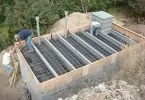Tornadoes are a widespread threat in the United States. Every year, thousands of homes are ripped apart by their destructive power. As a result, it’s becoming increasingly common for people to spend time and resources creating shelters to stay safe.
The instructions in this article will provide a basic overview of how to build a tornado shelter to protect yourself.
Table of contents
Planning & Permitting
There are many things to consider before you start building your shelter. It might take you longer to plan and research your structure than it will actually to build it!
The more time you spend on the research and consultation with professionals, the better you’ll be prepared when the building begins. Additionally, make sure to consult FEMA’sand NSSA guidelines.
You not only need construction approval, but you will also need to review your soil, wind, and flood zones.

FEMA has documentation that you should review before starting your planning.
In addition to FEMA, the National Storm Shelter Association (NSSA) has its industry standards.
Also, keep in mind that different states and towns have their own permitting requirements, so make sure you check with yours before you begin building.
Once you have reviewed the documentation above, there are other requirements to consider.
- You need soil analysis completed
- Assess the wind zones in the immediate area (wind zone map)
- Review your flood zone
Cost Considerations for Tornado Shelters
Cost considerations are going to be a big part of your planning. For example, do you want to build the shelter under your house, in your home, or outside and next to the house?
A very inexpensive shelter may cost you $500, but a solid, well-built shelter is going to run around $3,000 at a minimum. Depending on the size and what you want to have in the shelter, they can run up into the 10’s of thousands.
If you are building your house, incorporate your shelter into the design of the house. This will save you money and time.
If you want to build a shelter without changing the house’s construction, it may be less expensive to construct a separate building 150 feet away from the house. However, keep in mind that you’ll need to leave your home to enter the shelter, which can be dangerous during a tornado.
If you do choose this plan, it is essential you are prepared for a tornado.
Building Process
Let’s assume all planning and permitting are complete.
- Gather your materials – metal frames, concrete for the walls, floor, and roof, tools for general construction.
- Excavate the hole for the shelter. The hole will need to be large enough for you to maneuver, larger than the size you actually need.
- Size – Part of planning the size should include what you will need inside – first aid kit, number of people, emergency bag, etc. Good rules of thumb include 3sqft/person and 1sqft/emergency kit and supplies for each person.

Remember, a tornado does not last long. You need enough space for protection and not for a kitchen and bathroom.
Create the Tornado Shelter Floor
In addition to the steps below, your floor should be at least 5″ thick and placed on very level ground. You don’t need to worry about leveling the floor area if you build the shelter in your house.
- Drill holes through the ground floor of your house.
- Before you lay the concrete shelter floor, you’ll need to insert bolts into the holes.
- Ideally, you’ll make these anchors separately first. The anchors can be made using a metal frame.
- Pour the concrete into blocks to keep the anchors stable.
- Attach the shelter floor to the anchors.
- Lay the floor and wait for it to dry. It may take up to a week to dry.
- To protect your concrete from cracking while it dries, it’s advisable to pour water over your floor to keep it moist.
- The room should be well-ventilated to avoid the growth of mold. If you find mold, wash it and repaint the walls or roof where it gathered.
Prepare the Walls
The frame is one of the most critical parts of your storm shelter, especially since many of these shelters are underground.
The walls will need to be strong enough to withstand winds up to 250 mph, and ideally, they should be made from metal bars. Consider the tornado zone you are in and plan out each material you will use.
- Once the frame is created, it’s time to start arranging the concrete blocks to form the walls.
- Use a hammer drill to make holes in each concrete block. This will allow the frame you set to go through the partnerships, allowing for more stability in the entire structure.
- Begin by laying the first layer of blocks. Arrange them in an intersecting pattern so that every two blocks hold one more on top of them.
- After you’ve made the first concrete block later, pour concrete into the holes of the blocks. This will strengthen the link between the frame and the unions, creating a solid, immovable base.
- Again, keep in mind that if you don’t want cracks in the newly poured concrete, you may want to keep it wet as it cures.
- Repeat this process as you arrange each level of bricks.
- The entire shelter should be taller than the tallest member of your family- more than 7 or 8 feet.
Once you’ve reached this height, you’ll need to finish the edge. Later, you’ll attach the edge securely to the roof.
Roof & Preparation
Take your time when preparing your roof. A good fit with the walls is important, so there is no need to rush this part of the project.
- Thread the metal frame through all of your bricks so that it will lay perpendicular to the shelter’s frame.
- Drill holes through the bricks so that the empty spaces are facing up. You may need to break some of the compartments in each brick to create ample space.
- Add metal bars into the holes to stick out of the bricks and parallel to the walls’ frame.
- Pour concrete into the empty holes of the bricks. Again, soak the concrete with water as it cures.
- Once the concrete is dry, you’ll need to lay the roof’s edge over the edge of the shelter.
- Thread the metal bars of the walls through the edge of the roof.
- The metal bars sticking out of the top must be bent to attach to the walls securely.
- fuse additional metal bars on the roof, creating a criss-cross pattern like a chessboard.
Finishing the Roof
Once you have attached the roof to the shelter, only a few steps are left to finalize the roof.

- When you’ve finished attaching the roof, build a wooden frame to cover it.
- Pour concrete on top of the wooden frame to complete the roof.
- Drill some holes into the wooden frame to allow for ventilation.
Since tornadoes don’t last long, you don’t have to be highly concerned about ventilation. However, you’ll need to be able to stay inside of your shelter long enough to be rescued in case your exit is blocked by debris. This is especially important if you have a large family.
Tornado Shelter Door
The last thing you need to do is attach a door to your shelter, and this can’t be a door you decide to make yourself. Some doors are designed explicitly for these shelters. These doors are tested and certified by FEMA, so make sure you check all certifications before purchasing.
Usually, these unique doors are sold certified hinges, which are tested alongside the doors themselves. However, FEMA advises you not to use other hinges since they may put you in danger.
Tornado Shelter Options
The approach in this article can also be utilized in your basement.
Begin by laying the foundations, anchors, walls, and roof in the same way. Basements are safer than the house itself since they are built underground. This protects from the tornado, but not complete protection, as the wind can still destroy the house’s floor and compromise your safety.
Usually, tornado shelters are made using heavy materials, and the sheer weight of the tornado shelter can be enough to keep it in place. Keep this in mind when researching how to build your shelter.
Use a Safe Room
A safe room within your house can be good protection from a storm. We also have an article on tornado safe rooms you can check out.

Avoid building windows or other openings in your safe room, as they will weaken the construction. Instead, the only opening should be for the door, explicitly tested for tornado conditions.
Final Thoughts on Tornado Shelters
It would be best if you got advice from professional builders when creating your tornado shelter plans. This ensures the construction will withstand heavy pressures from wind and the impact of flying debris.
A shelter is only as good as its parts, and something as small as a hinge can compromise the safety of the people inside.
If this all seems overwhelming, you can always purchase a premade tornado shelter. These shelters can be attached to your existing house and come with a door, hinges, and first aid kits.






A shelter is important in that situation. I’d make sure not to leave many things outside the door of the shelter so as to not to obstruct me from getting out once the storm is over. Also, the deeper underground, the better.
I’ve gone through a few survival situations, and life doesn’t really care about how ready you are. I did my best, and fixed up an emergency kit using FEMA’s recommendation.
This is so important. One just cannot take emergencies lightly, and even when you think you’ve prepared, there is always room for improvement. My husband and I have already built a ‘panic room’ for our family. It’s not perfect and we’re improving it as best as we can bit-by-bit, but we’re sure it will prove its usefulness if need be. What I want to stress is the attitude one should have before, during and after emergencies, especially BEFORE. Try to simulate a disaster with your family, especially with the little kids, and try to do this regularly (we do at least once a month). I always educate my children that an emergency is no joke and there will be no do-overs in case you didn’t know what to do because you were consumed by panic.
One of the worst mistakes you can make when faced with an imminent disaster is being overcomed by sudden fear. The best way to avoid panicking is to be prepared in advance.